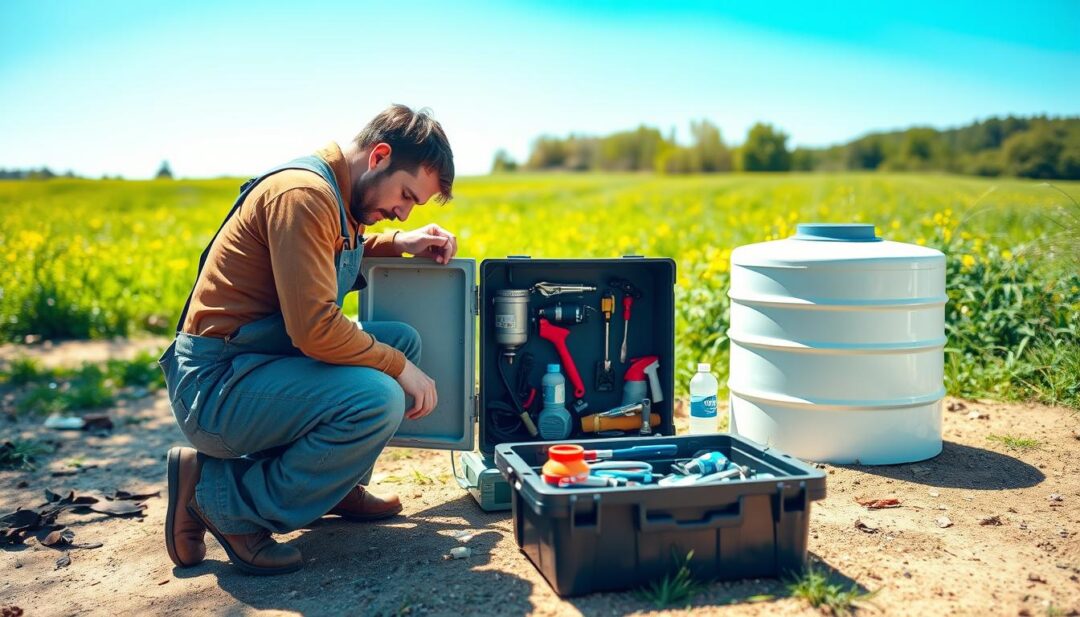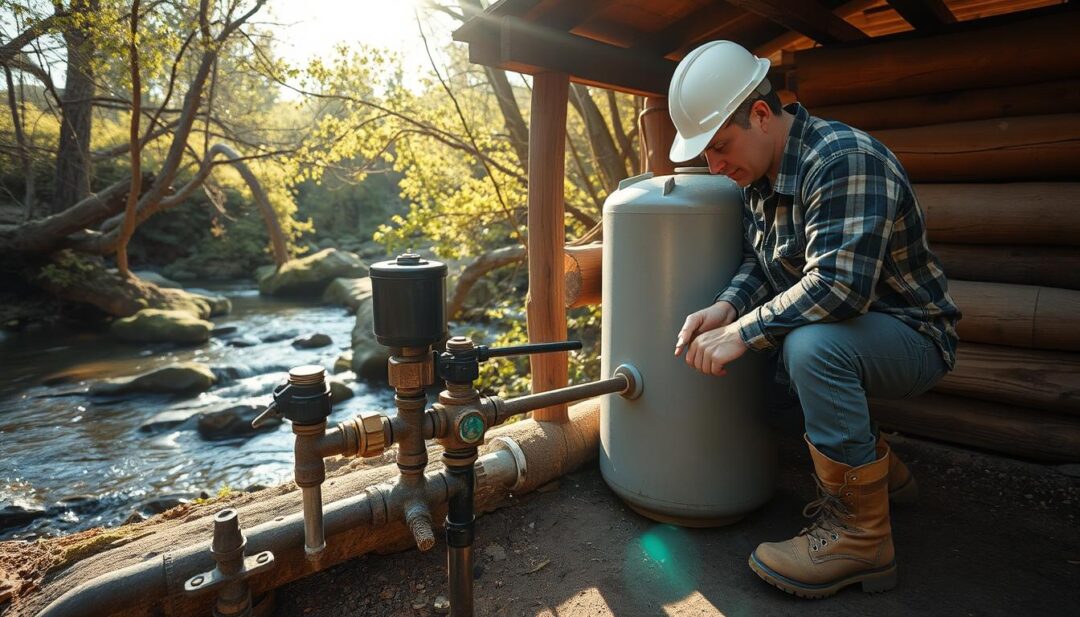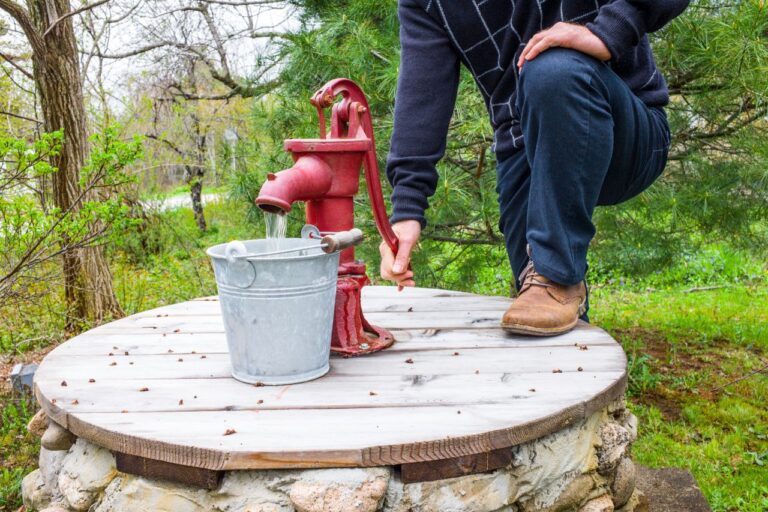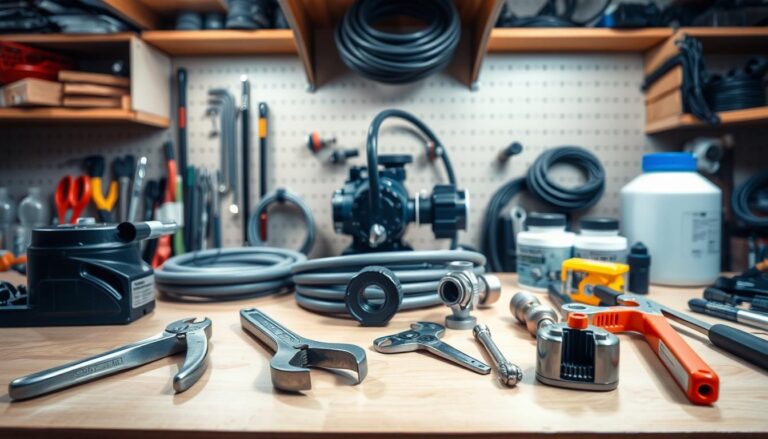Maintaining Your Off-Grid Water System Year-Round (With Minimal Fuss)
Did you know that having access to clean drinking water can be a lifeline during emergencies like power outages or natural disasters? In such situations, an off-grid water system becomes crucial. The general guideline for water storage is to have at least one gallon per person per day for a minimum of three days, with many experts advising a two-week supply.
Ensuring your water supply is reliable and well-maintained is vital. This not only involves storing water but also purifying it to make it safe for consumption. A well-maintained off-grid water system can provide peace of mind and security during unforeseen events.
Key Takeaways
- Store at least one gallon of water per person per day for emergency situations.
- Purification is key to making stored water safe for drinking.
- Regular maintenance is crucial for the longevity of your off-grid water system.
- A two-week supply of water is recommended by many experts.
- Having a reliable water system can provide security during emergencies.
Understanding Your Off-Grid Water System Components
Knowing the ins and outs of your off-grid water system’s components is vital for year-round functionality. An off-grid water system is made up of several key parts that work together to provide a reliable source of clean water.
Water Collection Methods
Water collection is the first step in an off-grid water system. There are primarily two methods used: rainwater harvesting and well systems.
Rainwater Harvesting Systems
Rainwater harvesting involves collecting and storing rainwater from rooftops or other surfaces. This method is particularly effective in areas with significant rainfall.
Well Systems and Pumps
Well systems, on the other hand, involve extracting water from underground aquifers using pumps. The type of pump used can vary depending on the depth of the well and the water requirements.
Storage Solutions
Once water is collected, it needs to be stored. The storage solution is critical for ensuring a steady supply of water.
Tank Materials and Longevity
Storage tanks can be made from various materials, including steel, plastic, and concrete. The choice of material affects the tank’s longevity and maintenance needs.
Sizing Requirements for Year-Round Use
Sizing the storage tank correctly is crucial to meet water demands throughout the year. Factors such as household size, water usage patterns, and local rainfall patterns influence the required tank size.
Filtration and Purification Systems
After collection and storage, water needs to be treated to make it safe for consumption. Filtration and purification systems remove contaminants and pathogens.
Mechanical Filtration Options
Mechanical filtration involves using filters with different pore sizes to remove particulate matter and some microorganisms.
Chemical and UV Treatment Methods
Chemical treatment involves adding disinfectants like chlorine or ozone to kill bacteria and viruses, while UV treatment uses ultraviolet light to achieve the same effect.
Essential Tools and Supplies for System Maintenance
The key to hassle-free off-grid water system maintenance lies in being prepared with the necessary tools and supplies. Having the right equipment on hand enables you to address issues promptly, reducing downtime and ensuring the continued supply of clean water.
Basic Maintenance Tool Kit
A basic maintenance tool kit for your off-grid water system should include a variety of wrenches, pliers, and screwdrivers. These tools will help you make adjustments, repair leaks, and perform routine maintenance tasks. It’s also beneficial to include a pipe cutter, Teflon tape, and a tubing cutter for handling pipes and tubing.
Recommended Spare Parts to Keep on Hand
Keeping a stock of recommended spare parts can significantly reduce repair time. Essential spare parts may include replacement valves, seals, and filters. It’s advisable to consult your system’s manual or contact the manufacturer to identify critical components that may need replacement over time.
Water Testing Equipment
Regular water testing is crucial for ensuring the quality and safety of your off-grid water supply. Invest in a water testing kit that can detect common contaminants such as bacteria, nitrates, and heavy metals. Regular testing allows you to identify and address water quality issues before they become major problems.
| Tool/Supply | Purpose | Recommended Quantity |
|---|---|---|
| Wrenches | Adjusting and repairing system components | 2-3 |
| Water Testing Kit | Monitoring water quality | 1-2 |
| Replacement Filters | Maintaining filtration system efficiency | 3-6 |
Creating a Year-Round Maintenance Schedule
A well-planned maintenance schedule is essential to ensure the optimal performance of your off-grid water system throughout the year. Regular maintenance is key to preventing issues and ensuring the longevity of the system.
Monthly Checks and Tasks
Monthly inspections should include checking the system’s overall performance, inspecting for leaks, and ensuring that all components are functioning correctly. It’s also crucial to test the water quality monthly to detect any contaminants or changes in water chemistry.
Quarterly Maintenance Activities
Quarterly, you should perform more in-depth maintenance tasks. This includes cleaning or replacing filters, inspecting the storage tanks for sediment buildup, and checking the condition of pipes and fittings. These tasks help maintain the system’s efficiency and prevent potential issues.
Annual System Overhaul
Annually, a comprehensive system overhaul is necessary. This involves inspecting and replacing worn-out parts, checking the integrity of the collection surfaces, and performing a thorough cleaning of the entire system. Documentation of these activities is crucial for tracking the system’s history and planning future maintenance.
Documentation and Record Keeping
Maintaining detailed records of all maintenance activities is vital. This includes noting the tasks performed, parts replaced, and any issues encountered. Accurate records help in diagnosing problems and planning future maintenance.
System Efficiency Assessment
Regularly assessing the system’s efficiency is crucial. This involves monitoring water production, checking for leaks, and ensuring that the system meets your water needs. Adjustments may be necessary based on seasonal changes or changes in water usage.
| Maintenance Task | Frequency | Purpose |
|---|---|---|
| System Performance Check | Monthly | Ensure overall system health |
| Filter Cleaning/Replacement | Quarterly | Maintain water quality |
| System Overhaul | Annually | Prevent major issues, replace worn parts |
Spring Maintenance: Preparing for Increased Usage
After a potentially harsh winter, spring maintenance is vital for your off-grid water system’s longevity and efficiency. As the weather warms up and usage increases, it’s essential to inspect and prepare your system for the coming months.
Post-Winter System Inspection
Begin by inspecting your off-grid water system for any damage or wear from the winter. Check for signs of freezing, cracking, or other forms of deterioration. Inspect all components, including pipes, tanks, and collection surfaces, to ensure they are in good condition.
Cleaning Collection Surfaces
Cleaning the collection surfaces is a critical task in spring maintenance. Remove any debris, such as leaves or branches, that may have accumulated over the winter. This will help ensure that your system can collect water efficiently. Use a mild detergent and water to clean the surfaces, and rinse thoroughly.
Preparing for Seasonal Rains
Spring often brings increased rainfall, which can be both beneficial and challenging for off-grid water systems. To prepare for seasonal rains, check your system’s capacity and ensure that it can handle the increased water flow.
Overflow Management
Proper overflow management is crucial to prevent damage to your system and surrounding areas. Ensure that your overflow valves are functioning correctly and that the water is directed away from the system’s components.
First Flush Diverter Maintenance
A first flush diverter is a valuable component of many off-grid water systems, allowing the initial flow of water from the roof to be diverted, taking debris with it, and then allowing clean water to flow into the storage tank. Check that your first flush diverter is working correctly and clean or replace it as needed.
| Spring Maintenance Task | Description | Frequency |
|---|---|---|
| Post-Winter System Inspection | Inspect system components for damage or wear | Annually |
| Cleaning Collection Surfaces | Remove debris and clean surfaces | Annually |
| Overflow Management | Check and maintain overflow valves | Annually |
| First Flush Diverter Maintenance | Check and clean or replace diverter | Annually |

Summer Maintenance: Maximizing Efficiency During Dry Periods
With the onset of summer, it’s essential to perform specific maintenance tasks on your off-grid water system to ensure it operates efficiently during dry periods.
Preventing Algae Growth
Algae growth in water storage tanks can be a significant issue during summer due to increased temperatures and sunlight exposure. To prevent this, consider using algae-resistant tank coatings or installing a floating intake valve that draws water from below the surface, reducing the likelihood of algae contamination.
Managing Water Conservation
Summer often means increased water usage, making conservation crucial. Implementing low-flow fixtures and promoting water-saving practices among users can significantly reduce consumption. Additionally, monitoring your system’s water levels and adjusting your usage accordingly can help maintain a sustainable supply.
Heat-Related System Protection
Heat can cause significant stress to your off-grid water system, particularly to storage tanks and pipes. Two key strategies to mitigate this are:
Shading Storage Tanks
Shading your storage tanks can reduce the impact of direct sunlight, lowering water temperatures and preventing algae growth. This can be achieved by installing tanks under a canopy or using shading materials around the tanks.
Monitoring Expansion and Contraction
As temperatures fluctuate, the materials of your water system (such as pipes and tanks) can expand and contract. Regularly inspecting these components for signs of stress or damage can prevent leaks and other issues.
| Summer Maintenance Task | Frequency | Benefit |
|---|---|---|
| Inspect for Algae Growth | Weekly | Prevents Contamination |
| Check Water Levels | Daily | Ensures Sustainable Supply |
| Monitor System Temperature | Monthly | Prevents Heat Damage |
Fall Maintenance: Transitioning to Colder Weather
Fall maintenance is a critical period for off-grid water systems, requiring attention to gutters, insulation, and system adjustments. As the weather cools, it’s essential to prepare your system for the challenges of colder temperatures.
Cleaning Gutters and Collection Systems
Cleaning gutters and collection systems is a vital task during fall maintenance. Debris such as leaves and branches can clog these systems, reducing their efficiency and potentially causing damage. Regular cleaning ensures that your off-grid water system continues to function optimally.
Insulation Preparation
Proper insulation is crucial for protecting your off-grid water system from freezing temperatures. Inspecting and upgrading insulation as needed can prevent pipes from freezing and bursting. This step is essential for maintaining the integrity of your system throughout the winter.
System Adjustments for Decreased Usage
As usage patterns change with the seasons, adjusting your off-grid water system to accommodate decreased demand is necessary. This may involve modifying flow rates or adjusting treatment processes to match the reduced water usage during the fall and winter months.
Winter Maintenance: Protecting Your System from Freezing
Freezing temperatures can severely impact your off-grid water system, making winter maintenance essential. Ensuring your system is protected from freezing is crucial for maintaining a reliable water supply throughout the winter months.
Insulating Vulnerable Components
One of the key steps in winter maintenance is insulating vulnerable components of your off-grid water system. This includes pipes, pumps, and valves that are exposed to the cold.
Pipe Insulation Techniques
Proper insulation of pipes can be achieved using foam pipe insulation or wrapping pipes with heat tape. Foam pipe insulation is a cost-effective method that provides excellent protection against freezing temperatures.
Pump and Valve Protection
Pumps and valves are critical components that require protection. Using insulated covers or heated enclosures can help maintain their functionality during extreme cold.
Managing Snow and Ice Buildup
Snow and ice buildup around your off-grid water system can lead to issues such as frozen pipes or damaged components. Regularly clearing snow and ice from around the system is essential.
- Clear snow from around the system’s components.
- Use salt or sand to prevent ice formation on walkways and around the system.
- Ensure that the system’s drainage is not obstructed by ice or snow.
Emergency Procedures for Extreme Cold
Having emergency procedures in place is vital for dealing with extreme cold snaps. This includes having backup systems and knowing how to thaw frozen components safely.
Backup Systems Implementation
Implementing backup systems, such as secondary water sources or emergency generators, can ensure continuity of your water supply during prolonged cold periods.
Thawing Frozen Components Safely
If a component freezes, it’s crucial to thaw it safely to avoid damage. Using gentle heat sources or professional thawing services can help restore functionality without causing harm to the system.
| Component | Winter Protection Method | Benefits |
|---|---|---|
| Pipes | Foam Insulation or Heat Tape | Prevents Freezing, Reduces Damage Risk |
| Pumps and Valves | Insulated Covers or Heated Enclosures | Maintains Functionality, Extends Lifespan |
| System Area | Snow Clearing, Salt or Sand Application | Prevents Ice Buildup, Ensures Accessibility |
Maintaining Your Off-Grid Water System Year-Round With Minimal Fuss: Expert Tips
To keep your off-grid water system running smoothly year-round, it’s essential to implement effective maintenance strategies. By doing so, you can ensure a reliable water supply while minimizing the workload associated with system upkeep.
Automation Solutions for Reduced Workload
Automation can significantly simplify off-grid water system maintenance. Two key automation solutions include:
- Smart monitoring systems that track water quality, pressure, and flow rate in real-time, enabling prompt issue detection and resolution.
- Automatic valves and controls that regulate water distribution, reducing manual intervention and the risk of human error.
Smart Monitoring Systems
Smart monitoring systems provide real-time data on your water system’s performance, allowing for swift identification and rectification of problems.
Automatic Valves and Controls
Automatic valves and controls streamline water distribution, minimizing the need for manual adjustments and reducing the likelihood of errors.
Time-Saving Maintenance Hacks
Several time-saving maintenance hacks can help optimize your off-grid water system’s performance. These include:
- Regularly inspecting and cleaning system components to prevent clogging and damage.
- Using a sediment filter to reduce particulate matter and prolong system lifespan.
When to Call in Professional Help
While many maintenance tasks can be performed by system owners, there are instances where professional assistance is necessary. If you encounter complex issues or are unsure about how to address a problem, it’s best to consult a qualified technician to ensure your system remains in good working order.

Water Quality Testing and Treatment Protocols
Regular water quality testing is essential to ensure your off-grid water system remains safe and functional year-round. Water quality can fluctuate due to various factors, including seasonal changes, environmental conditions, and system maintenance.
Seasonal Water Quality Variations
Seasonal variations can significantly impact water quality. For instance, during heavy rainfall, surface water sources may become contaminated with runoff containing sediments, bacteria, and other pollutants. Conversely, during dry seasons, water sources may become more concentrated with minerals and other contaminants.
Understanding these seasonal fluctuations is crucial for maintaining water quality. Regular monitoring helps in identifying potential issues before they become major problems.
DIY Testing Methods and Frequency
DIY testing is a practical approach to regularly monitor your water quality. Simple tests can be conducted using kits available in the market, checking parameters like pH, turbidity, and presence of certain bacteria or chemicals.
- pH levels
- Turbidity
- Bacterial presence
- Chemical contaminants
The frequency of testing should be adjusted based on seasonal variations and system usage.
Treatment Options for Common Contaminants
Once contaminants are identified, appropriate treatment options must be employed.
Bacterial Contamination Solutions
For bacterial contamination, treatment options include UV purification, chlorination, and filtration systems with pore sizes small enough to capture bacteria.
Mineral and Chemical Treatment
Mineral and chemical contaminants can be addressed through various methods, including activated carbon filtration, reverse osmosis, and ion exchange systems.
| Contaminant Type | Treatment Option |
|---|---|
| Bacterial | UV Purification, Chlorination |
| Mineral/Chemical | Activated Carbon, Reverse Osmosis |
“The quality of water is crucial not only for drinking but also for overall health and hygiene.” –
Conclusion
Maintaining an off-grid water system requires ongoing effort, but with the right strategies, it can be done efficiently. Regular maintenance is crucial to ensure the system’s optimal performance and longevity. As discussed, a well-maintained off-grid water system can provide independence from municipal water sources, reduce environmental impact, and offer long-term cost savings.
For instance, a homestead with a 20′ x 20′ roof can catch rainwater, filling a 1500-gallon water tank, and use a Berkey filter for clean drinking water. Future plans may include building a larger roofline and feeding water into a larger elevated water tank for a gravity-fed system, as seen in some successful implementations.
The cost of an off-grid water system can vary significantly, ranging from $2,000 to $10,000 for basic systems, and upwards of $20,000 for more advanced systems. To minimize costs, it’s essential to implement energy-efficient components and renewable energy sources, as well as water-saving practices, which can be found in resources like off-grid water system guides.
By following the maintenance schedule and tips outlined in this article, you can ensure your off-grid water system operates smoothly throughout the year. Being prepared and proactive is key to maintaining a reliable and efficient off-grid water system.







